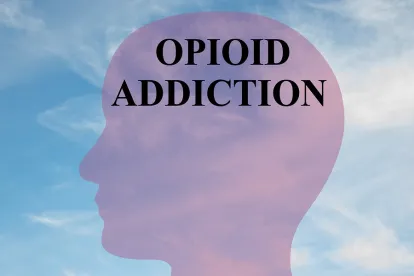As the world fights to contain the spread of the novel Coronavirus (COVID-19), the U.S. continues to combat another domestic public health issue: the opioid epidemic, the crisis created by prescription and illicit opioid misuse, addiction, and overdose. Providers treating patients with opioid use disorder (OUD) have found Medication-Assisted Treatment (MAT), which utilizes medications combined with psychosocial and other behavioral health support services, to be an effective treatment tool. A common medication used in the context of MAT for OUD patients is buprenorphine—a Schedule III controlled substance under the federal Controlled Substances Act (CSA).
Under the CSA, specifically, the Ryan Haight Online Pharmacy Consumer Protection Act of 2008 (the Ryan Haight Act), in order to prescribe a controlled substance, an authorized provider is required to conduct at least one in-person examination of the patient, unless an exception applies. But due to the COVID-19 public health emergency, this in-person requirement has become a barrier to treatment, as patients and providers are advised to shelter at home to prevent further spread of the virus. In response, governmental authorities are relaxing restrictions, and allowing providers to meet the in-person examination requirement through alternative means, including telemedicine.
Specifically, on March 16, 2020, the Drug Enforcement Agency (DEA) activated the public health emergency exception to the Ryan Haight Act, which allows providers to prescribe controlled substances via telemedicine without first conducting an in-person examination. Under this emergency exception, practitioners can prescribe controlled substances to patients through the use of “telemedicine technologies,” which requires the use of an audio-visual, real-time, two-way interactive communication system. (See our prior article for a more in-depth discussion of the Ryan Haight Act).
Recently, DEA further expanded this controlled substances prescribing exception for “authorized practitioners” treating OUD patients. According to a recent letter issued by DEA (the DEA Letter), in partnership with the Substance Abuse and Mental Health Services Administration (SAMHSA), as of March 31, 2020, the DEA will allow “authorized practitioners” to prescribe buprenorphine to new and existing OUD patients for maintenance or detoxification treatment on the basis of telehealth examination, which may include a telephone voice-only evaluation—without the need for a prior in-person exam.
The DEA Letter follows SAMHSA’s March 19, 2020 guidance, which independently allowed Opioid Treatment Program (OTP) providers and DATA-waived practitioners to treat patients with buprenorphine via telehealth, including audio-only (telephone) communications, without first conducting an in-person physical evaluation.
Modality Flexibility
The DEA Letter allows authorized practitioners the added flexibility of using audio-only modalities (i.e., telephone)—instead of audio-visual, real-time, two-way interactive communication system—which is required to prescribe controlled substances via telemedicine, pursuant to the aforementioned emergency exception to the federal Ryan Haight Act.
Who Is An “Authorized Practitioner”?
As referenced in the DEA Letter, this exemption only applies to “authorized practitioners,” which refers to practitioners who work in a registered opioid treatment program (OTP provider) or “DATA-waived practitioners.”
OTP Providers
Under federal law, practitioners can prescribe and dispense narcotic drugs, including buprenorphine, to individuals with OUD for maintenance or detoxification treatment, if the practitioners work in an OTP, which requires separate registration with DEA.
DATA-Waived Practitioners
Under the federal Drug Addiction Treatment Act (DATA 2000), qualified practitioners may apply for a waiver to prescribe or dispense buprenorphine for the treatment of OUD outside of an OTP setting. Qualified practitioners who meet certain licensure, training, and educational requirements, can apply with SAMHSA for the waiver, and once approved, are authorized to prescribe or dispense buprenorphine for OUD patients in any setting the practitioner is otherwise credentialed to practice. These practitioners are often referred to as “DATA-waived practitioners.”
Limitations
In sum, pursuant to recent DEA and SAMSHA guidance, OTP providers and DATA-waived practitioners can treat new and existing patients with buprenorphine related to maintenance or detoxification treatment following an evaluation via telehealth, including audio-only telephone calls, without first performing an in-person or telemedicine evaluation.
However, this allowance is subject to the following limitations:
-
The evaluating practitioner must determine that an adequate patient evaluation can be conducted over the telephone.
-
The prescription also must otherwise be consistent with the practitioner’s obligation under the Controlled Substances Act, DEA regulations and general standards of practice to only prescribe controlled substances for a legitimate medical purpose while acting in the usual course of his or her professional practice.
-
DATA-waived practitioners must comply with all applicable standards of care. In such a case, the patient will count against the practitioner’s patient limit imposed by the waiver and must treat the patient in accordance with any rules that apply to practicing with a waiver under 21 U.S.C. § 823(g)(2), and 42 C.F.R. Part 8, as applicable.
-
The DEA and SAMHSA flexibilities only apply to prescribing and dispensing buprenorphine to new or existing patients—the exemption does not apply to new patients treated with methadone or other controlled substances used in MAT.
Even with these flexibilities granted in response to the COVID-19 public health emergency, practitioners must comply with both federal and state laws. Some states prohibit the prescribing of controlled substances, including buprenorphine, via telemedicine, some allow it with restrictions, whereas other states broadly allow it. Additionally, many states have announced public health emergency exceptions to telemedicine prescribing of controlled substances on a state-by-state basis. In any event, prior to an authorized practitioner acting pursuant to the relaxed guidance, applicable state law must be consulted.
For additional web-based resources available to assist you in monitoring the spread of the coronavirus on a global basis, you may wish to visit the websites of the CDC and the World Health Organization.



 />i
/>i

